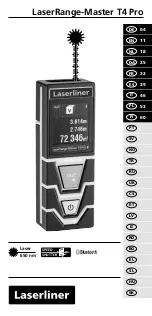
Front Panel Operation
2-118
2.19.4 TEST
The SELF-TEST MENU is used as a diagnostic tool to iso-
late problems with the Model 6517A. Information on using
these test procedures is included in the optional Model 6517
Service Manual.
2.19.5 LIMITS
The LIMITS menu is used for the following operations:
• To set and control the limit values that determine the
PASS/FAIL and HI/LO status of subsequent measure-
ments.
• To set the digital output patterns that signify passing or
failing limit checks.
• To enable/disable a binning strobe signal on digital out-
put #4 for triggering a user-supplied device handler.
NOTE
Since the logic sense of the digital output
lines is programmable (high-true or low-
true), this discussion of limits uses the log-
ical terms TRUE/FALSE and ON/OFF,
rather than HIGH and LOW.
There are two sets of limits, each with high and low limit val-
ues. You can program and enable one or both limit sets. With
both sets enabled, the values can overlap of one set can be in-
cluded in the other. The only restriction is that, within the
same set, the high limit must be greater than the low limit for
a valid test.
The limit test is performed after MATH operations. Unit pre-
fixes are applied before the limit test, for example:
• Low limit = -10.0, High limit = 10.0. A 1.5V reading
passes (PASS).
• Low limit = -10.0, High limit = 10.0. A 0.6M
Ω
reading
equals 600,000 (FAIL).
Limit set #1 is available as a multiple display, which shows
a bar graph and a pass/fail indication for the measurements.
While the limits bar graph is displayed, the programmed val-
ues for limit set #1 can be viewed by pressing INFO.
The digital output lines can be programmed to reflect the re-
sults of limit tests. The first test that fails sets a programma-
ble digital output pattern, where the test execution order is
LOW1, HIGH1, LOW2, HIGH2. If all tests pass, another
programmable pattern is set. (Also see DIGOUT in para-
graph 2.19.7).
LIMIT-SET-1 and LIMIT-SET-2
These menu items are similar in that you can enable or dis-
able either or both limit sets, and program the high and low
limit values for either or both limit sets.
The options for these menu items are explained as follows:
CONTROL: This item enables or disables control of the dig-
ital output lines by the results of either or both limit set tests.
For example, to let limit set #1 control the digital output
lines, highlight the CONTROL item in the previous menu
and press ENTER. Then highlight the ENABLE item in the
next menu and press ENTER. The instrument returns to the
LIMIT SET #1 MENU.
LOLIM1, HILIM1, LOLIM2, HILIM2: These items allow
you to set values for the low and high limits, and the action
performed on the digital output lines for each limit test fail-
ure. After selecting a limit, the value for that limit will be dis-
played. To change the limit, use the cursor keys and the range
keys to display the desired value. Note that you must enter
values in scientific notation.
Press ENTER to select your value and display the next menu,
which selects the digital output action to be taken if the se-
lected limit is the first limit to be exceeded. The digital out-
puts can be toggled between ON and OFF with the range
keys.
Each measurement function has a multiple display for the
limits bar graph. It shows a pass/fail indication and a graph-
ical representation of the reading compared to limit set #1. If
low limit #1 is less than high limit #1, you will see a display
similar to that shown in Figure 2-77.
Note that the Model 6517A does not check the validity of the
high and low limit values when you enter them. If low limit
#1 is greater than or equal to high limit #1, the following
message is shown on the bottom line of the limits bar graph
next display:
No bar graph: LLIM1 >= HLIM1
The programmed values for limit set #1 are shown by press-
ing the INFO key from the limits bar graph next display.
Содержание 6517A
Страница 1: ...Model 6517A Electrometer User s Manual A G R E A T E R M E A S U R E O F C O N F I D E N C E...
Страница 310: ...A Specifications...
Страница 311: ...A Specifications...
















































